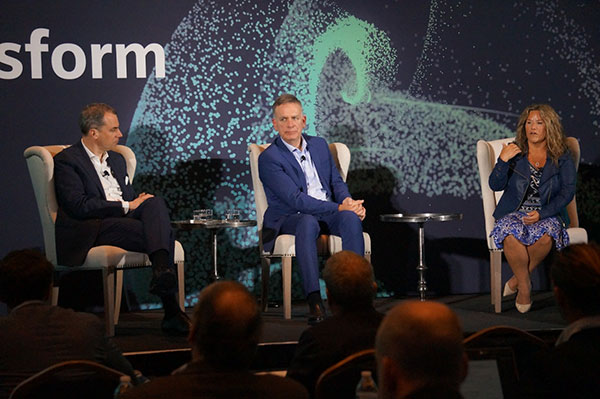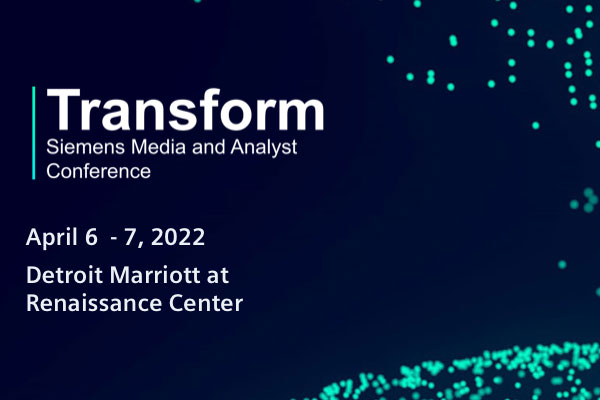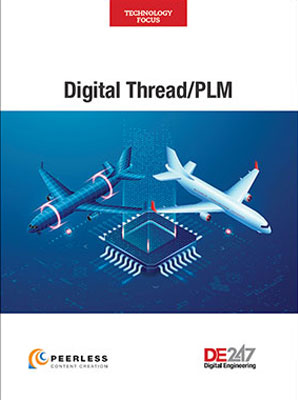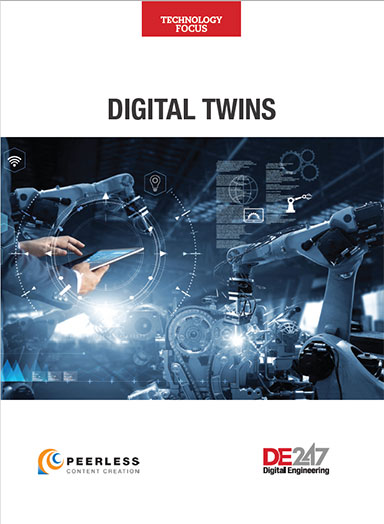Navigating the Transformation of Software Innovations
Radically changing the way we do business via software-as-a-service offerings was the focal point of a Siemens-hosted analyst and media event in April.

An executive panel of Siemens leaders addressed audience questions pertaining to Siemens products. From left: Cedrik Neike, Tony Hemmelgarn, Brenda Discher. Image courtesy of Siemens.
Latest News
April 14, 2022
In this future-focused world, the entirety of the Siemens Digital Industries product portfolio is running on transformation, especially in its transition to software-as-a-service. Transformation, a theme threaded throughout a recent Siemens 2-day event, can be found within Siemens’ ever-evolving product portfolio and in customers’ approach to the way they do business.
Tony Hemmelgarn, president and CEO of Siemens, provided one of the opening keynotes at the Siemens 2022 Media and Analyst Conference in the Motor City April 6-7, tackling the vision/strategy for Siemens software. He was joined on stage at the opening day event by Brenda Discher, SVP, business strategy and marketing, who addressed the software-as-a-service transition; and Cedrik Neike, member of the managing board of Siemens AG and CEO, Digital Industries, who talked about the digital industries vision.
The three later shared insights at an executive Q&A open to audience participation. They were among close to a dozen speakers who during the event addressed topics such as Xcelerator-as-a-Service, PLM in the cloud, digital twin solutions at scale and digital manufacturing and the impact on supply chain.

Xcelerator-as-a-Service, with the addition of NX X, a cloud-based computer-aided design (CAD) program, stole the spotlight at the event. The goals, according to Hemmelgarn, are threefold: make the software easier to access, integrated and more open.
It is built on connectivity—database connectivity, component connectivity and app connectivity with the ability to be flexible and agile to meet customers’ demands. Ease of operations is also part of the package, too, according to Hemmelgarn.
“We talk a lot about Xcelerator. It’s about all the things we bring together to help our customers create a better enterprise,” Hemmelgarn says.
“The kinds of problems our customers are dealing with are big and challenging. They say they need [the process] to be easier,” he says.
Xcelerator-as-a-service operates as an “intelligent supply chain solution. If anything, when you think about the pandemic and the supply chain—it’s almost like the butterfly effect—one little small local disruption and before you know it, you’ve got problems throughout the entire flow of the system. Our integrated supply chain solution helps manage disruptions,” Hemmelgarn explains.
Unique and interesting customer case studies were interspersed throughout the event highlighting large-scale operations such as aviation expert Lockheed and automotive OEM Hyundai to niche-oriented SMB startups that focused on drones (Saildrone) and biospheres (Nemo’s Garden). Nearly 30 companies’ stories were acknowledged.
At the event, Siemens shared an intriguing example of Xcelerator put to use — underwater. Nemo’s Garden is a startup launched in 2021 that aims to maintain sustainable underwater crop cultivation. Engineers, divers and scientists are on a mission to prove the capability of cultivating herbs, fruit and vegetables underwater via use of a sub-aqua biosphere or underwater greenhouse.The company is using Xcelerator to move toward industrialization and scale.
The challenge the company faced was transforming the prototype into a global solution.
“When I first saw Siemens’ digital twin technology, I was mesmerized. Nemo’s Garden is a one-of-a-kind system and we need to adapt to each environment where it is to be installed. If you can model that environment virtually before you start, you can foresee the challenges and address them in the best way,” said Luca Gamberini, Co-Founder, Nemo’s Garden. “We have a greater understanding of the points of stress on the structure around the biospheres. We also understand how the different interactions of the solar radiation, the temperature and all the physical factors, act on the plants. All thanks to the ability of the digital twin to replicate our system.”
In the automotive case example, Hemmelgarn addressed how Hyundai had been using the same tooling operations for 40 years and realized, “We’ve got to change our model,” deciding to select Siemens for model-based engineering.
“It was easy to make the transformation. We integrated their processes,” he says.
He says it’s not unusual for customers to approach the Siemens’ team, asking, “‘Can you help me with a need I have for my employees to acquire a new skill?’ These skills involve significant changes in the way work gets done,” Hemmelgarn says. “At Siemens, we believe applications will get a lot smaller and will be driven by services or business capabilities. This modular approach will [lead to] an explosion in the number of personalized applications. Customers want open solutions that they can personalize and adapt to.”

Addressing such concerns and building these applications “has never been easier with Xcelerator. Customers can make real-time decisions. It helps optimize use of equipment and resources and optimize the fulfillment center,” he says.
The affirmation of success is achieved when Hemmelgarn hears back from such customers: “You’ve helped me go from uncertainty to certainty.”
Workflow Disruption
Addressing the way customers work post-pandemic 2020s, Hemmelgarn is convinced: “We are changing the way we are working. We are closing the gap between shop floor and top floor with these applications,” he says. “We continue to find ways to integrate and work together.”
With the Xcelerator portfolio it is possible, according to Hemmelgarn, to integrate video feeds, monitor business applications, and find out what’s happening with industrial equipment to optimize in real time.
Siemens isn’t operating alone in such endeavors. The company openly acknowledges successful collaborations and partnerships formed with companies such as AWS, SAP, Accenture and others.
Circular Economy Noted
Hemmelgarn notes it is rather challenging in today’s world to talk to a customer without sustainability entering the conversation. “We hear: ‘We are making sustainability commitments; but we have obstacles; we need your help.’”
He says it’s common, for example, for companies to need help with tax credit calculations and how it’s reported. “They realize that sustainability has to be a part of the process. They see us as being able to enable the collective intelligence—everything they need to engineer what we define as the circular economy.”
In helping customers with carbon reductions, for many years, Hemmelgarn says Siemens had a Teamcenter solution that aided with costing. “Now what we provide for customers focuses on cost and carbon footprint—CO2 tax calculations, transportation costs, etc.,” he says.
Also part of the sustainability solution, the digital twin has gotten plenty of play over the last few years. “Now we are taking it to the next level—what does it mean to have it operate or monitor and optimize performance and sustainability in real time? We call this the executable digital twin,” he says.
The executable digital twin entails taking simulation models, simulating the process and loading them on Siemens Edge devices for automation.
“Customers who now are faced with new business models—new ways of working—they want a partner with competency,” Hemmelgarn says.
“We continue to show that companies large and small trust Siemens with workforce transition and sustainability goals. We believe the success of our relationship with our customers centers on Xcelerator. With Xcelerator we can deliver all of this in an easy, open, and integrated way,” Hemmelgarn says.
Brenda Discher, who expounded on SaaS transition and XaaS, says what is fundamentally changing is the future of work.
“The way we work has changed forever. That has enabled us, as we launch our Xcelerator as a service offerings, to marry that new business model with the cultural transformation that our customers are encountering. This transformation is happening in every industry to every size customer—whether hardware or software,” she says.
“If there’s one thing that is interesting about this transformation, is that it’s changing the way we work as a company too. There’s a lot of talk about the openness that is changing the way we work,” she says, noting, “Siemens is transforming to become a tech company.”
Software is at the core of Siemens’ transformation. The company is also transforming in marrying IT and OT. “We truly believe our customers want to dream the world’s most innovative product. They want to dream of new processes that will improve their resiliency and sustainability. They want to dream of new ways of automating their factories.”
The customer’s world is changing too, Discher concludes. “Every single customer in every industry, large and small, every customer is faced with the need for transformation. Change is upon us all the time.”
For prior coverage related to the event, check out the following:
More Siemens Digital Industries Software Coverage
Subscribe to our FREE magazine, FREE email newsletters or both!
Latest News
About the Author
Stephanie is the Associate Editor of Digital Engineering.
Follow DE





